
 |
|
 |
 |
|||||||
|
|
|||||||
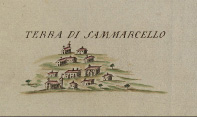 The
battle of Gavinana, during which, on the 3 august 1530, the captain of the
army of the Florentine Republic Francesco Ferrucci, was wounded, captured
and killed (by hand of the enemy commander Fabrizio Maramaldo), marks a
deep historical division in the history of Tuscany. It announced the fall
of the sieged city of Florence and therefore the definitive return to power
of the Medici family, thanks to the important role played by Pope Clement
VII and the protection of Emperor Charles V, leading the way to the transition
from the republican era to the Medicean Princedom, established by Duke Cosimo
I around the mid-16th century. The battle, which ended with the conflict
of Gavinana, also represents an important turning point for Pistoia's Mountains: The
battle of Gavinana, during which, on the 3 august 1530, the captain of the
army of the Florentine Republic Francesco Ferrucci, was wounded, captured
and killed (by hand of the enemy commander Fabrizio Maramaldo), marks a
deep historical division in the history of Tuscany. It announced the fall
of the sieged city of Florence and therefore the definitive return to power
of the Medici family, thanks to the important role played by Pope Clement
VII and the protection of Emperor Charles V, leading the way to the transition
from the republican era to the Medicean Princedom, established by Duke Cosimo
I around the mid-16th century. The battle, which ended with the conflict
of Gavinana, also represents an important turning point for Pistoia's Mountains:
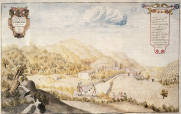 it marks
somewhat the end of a long turbulent period full of contrast between the
various factions that were trying to control Pistoia and its territory and
it marked the start of the long peace "of Cosimo", characterized
on one hand by different forms of political and economical exploitation,
and on the other by specific strategies for development, the most important
being the introduction of the metal industry which was then to be established
in several places on Pistoia's Mountains and with an operative site in Maresca. it marks
somewhat the end of a long turbulent period full of contrast between the
various factions that were trying to control Pistoia and its territory and
it marked the start of the long peace "of Cosimo", characterized
on one hand by different forms of political and economical exploitation,
and on the other by specific strategies for development, the most important
being the introduction of the metal industry which was then to be established
in several places on Pistoia's Mountains and with an operative site in Maresca.
|
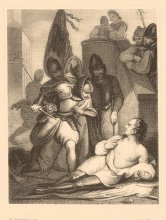 The
figure of Ferrucci, protagonist and victim of the army, with the cunningness
and disorder that led the troubled events of the 16th century, has progressively
moved from a historical level to a more legendary and literary one, embodying
the quintessence of heroism and pride, as opposed to that of treachery represented
by the figure of "Maramaldo", who in the name of revenge kills
a helpless man, "a dead man". The
figure of Ferrucci, protagonist and victim of the army, with the cunningness
and disorder that led the troubled events of the 16th century, has progressively
moved from a historical level to a more legendary and literary one, embodying
the quintessence of heroism and pride, as opposed to that of treachery represented
by the figure of "Maramaldo", who in the name of revenge kills
a helpless man, "a dead man".The legend of Francesco Ferrucci, as brave defender of the republican ideals of freedom and independence from the tyrant and foreigner, was later revived and celebrated particularly during the Renaissance and Post-renaissance periods, when the places touched by Ferrucci became famous for patriotic and laic pilgrimage. Ferrucci's name was even inserted in the Italian national anthem as symbol for the great feeling of pride. Amongst the famous figures that came to the Pistoia's Mountains to pay their respects to the "hero of Gavinana" were those of Niccolò Puccini, Massimo d'Azeglio, Francesco Domenico Guerrazzi, Giuseppe Garibaldi, Niccolò Tommaseo, Raffaele Cadorna and Ferdinando Martini. To honor the figure of Ferrucci, a monument was erected in the square of Gavinana, started in 1913 and completed in 1920 by the Florentine artist Emilio Gallori. Following the celebrations of the 500th anniversary commemorating Ferrucci's death (1530-1930), the Battistini house where, according to the popular and iconographic tradition, Fabrizio Maramaldo killed the Florentine captain, was bought and restored.  A
museum and library were then set up in this house with the purpose of preserving
important memorabilia, historical and artistic documents, such as weapons
and armour, photographs and engravings, sculptures and paintings, brochures
and books, flags and costumes of the "Giuoco del Calcio fiorentino"
(The Game of Florentine Football). Between 1956 and 1957 the museum was
once again re-organized by Renzo Chiarelli in different thematic sectors:
the Weapons Room, the Room of Azeglio and the Battle, the Francesco Ferrucci
Room, the Siege and Flag Room. (For information contact: the Public Library
of San Marcello - Biblioteca Comunale di San Marcello, phone: 0573-621289). A
museum and library were then set up in this house with the purpose of preserving
important memorabilia, historical and artistic documents, such as weapons
and armour, photographs and engravings, sculptures and paintings, brochures
and books, flags and costumes of the "Giuoco del Calcio fiorentino"
(The Game of Florentine Football). Between 1956 and 1957 the museum was
once again re-organized by Renzo Chiarelli in different thematic sectors:
the Weapons Room, the Room of Azeglio and the Battle, the Francesco Ferrucci
Room, the Siege and Flag Room. (For information contact: the Public Library
of San Marcello - Biblioteca Comunale di San Marcello, phone: 0573-621289).
|
| (...) Dall'Alpi a Sicilia (...) From
the Alps to Sicily Dovunque è Legnano, Legnano is everywhere; Ogn'uom di Ferruccio Every man of Ferruccio Ha il core, ha la mano, Has a heart, has a hand, I bimbi d'Italia The children of Italy Si chiaman Balilla, They are named "Balilla", Il suon d'ogni squilla Every bell rings I Vespri suonò. Sounds of the (Sicilian) Vespers. Stringiamci a coorte Let us join in cohort, Siam pronti alla morte We are ready to die! L'Italia chiamò. (...) Italy has called! |
 The
existence of a Captain controlling the Mountain territory and population
dates back to the end of the 1320s. This figure of authority, ordered by
the city of Pistoia, resided on the highlands surrounded by the deep gorges
of the streams Verdiana and Lima in the fortress of Castel di Mura, of which
little remains today. "The Captain was in charge for three months:
he was given a horse and controlled 6 families, with a salary of 72 liras.
His specific tasks included maintaining order in the villages under his
jurisdiction: Popiglio, Piteglio, Mammiano, San Marcello, Gavinana e Lizzano
and later a little Cutigliano. He had to monitor the payment of tolls and
he administrated local justice with the power of issuing monetary fines
up to 10 liras." (E. Biagini, San Marcello dalle origini all'età
comunale, Pistoia 1992, p. 28). In the second half of the 14th century,
the Captain's headquarters were moved to Lizzano, and in 1373, when control
had passed into the hands of the city of Florence, they were moved to Cutigliano,
where he resided during the summer months. Later, three different headquarters
were established: Lizzano, Cutigliano and San Marcello, then reduced to
two after 1512, when Lizzano was excluded. The headquarters in San Marcello
were in the old estate of Lord Guidi, which are no longer there today. The
existence of a Captain controlling the Mountain territory and population
dates back to the end of the 1320s. This figure of authority, ordered by
the city of Pistoia, resided on the highlands surrounded by the deep gorges
of the streams Verdiana and Lima in the fortress of Castel di Mura, of which
little remains today. "The Captain was in charge for three months:
he was given a horse and controlled 6 families, with a salary of 72 liras.
His specific tasks included maintaining order in the villages under his
jurisdiction: Popiglio, Piteglio, Mammiano, San Marcello, Gavinana e Lizzano
and later a little Cutigliano. He had to monitor the payment of tolls and
he administrated local justice with the power of issuing monetary fines
up to 10 liras." (E. Biagini, San Marcello dalle origini all'età
comunale, Pistoia 1992, p. 28). In the second half of the 14th century,
the Captain's headquarters were moved to Lizzano, and in 1373, when control
had passed into the hands of the city of Florence, they were moved to Cutigliano,
where he resided during the summer months. Later, three different headquarters
were established: Lizzano, Cutigliano and San Marcello, then reduced to
two after 1512, when Lizzano was excluded. The headquarters in San Marcello
were in the old estate of Lord Guidi, which are no longer there today. |
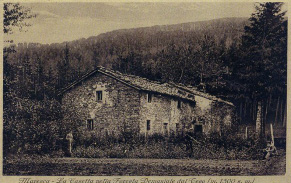 As
mentioned by Repetti in the 1850s, the royal estate along the mountain ridge
between Crocicchio and scrub of Orsigna near Maresca, "was destined
to the propagation of a new fir tree", and during the summer period
was used as grazing land and for the breeding of the "royal thoroughbreds",
which were moved to the estate in Coltano, located in the scrub of San Rossore,
between Pisa and Leghorn. Since the 17th century, Pistoia's Mountains have
been used to breed the Gran Duke's horses, as is still confirmed today by
the various place-names, specifically by the "Casetta dei Puledrari"
(Home of the Stable Boys), which was in the highest part of the Teso Forest
(1200 meters altitude), which today hosts a hotel and restaurant structure,
camping site and a ring circuit for cross-country skiing. As
mentioned by Repetti in the 1850s, the royal estate along the mountain ridge
between Crocicchio and scrub of Orsigna near Maresca, "was destined
to the propagation of a new fir tree", and during the summer period
was used as grazing land and for the breeding of the "royal thoroughbreds",
which were moved to the estate in Coltano, located in the scrub of San Rossore,
between Pisa and Leghorn. Since the 17th century, Pistoia's Mountains have
been used to breed the Gran Duke's horses, as is still confirmed today by
the various place-names, specifically by the "Casetta dei Puledrari"
(Home of the Stable Boys), which was in the highest part of the Teso Forest
(1200 meters altitude), which today hosts a hotel and restaurant structure,
camping site and a ring circuit for cross-country skiing.
|
 One
of the main activities of the Mountain of Pistoia was the one connected
to working the iron mineral extracted from the Isle of Elba and brought
to these areas to be processed and worked using the natural richness of
the water ways and woodland. From 17 March 1543, after Cosimo I and Iacopo
IV of Piombino signed an agreement, this activity became a true state monopole.
Evidence of this can be found in the numerous architectural structures still
standing today, in Gavinana (the Appiani building, later called Achilli,
which today is the Information Point of the Eco-museum), in Maresca and
other villages. The Eco-museum has dedicated a lot of research to this primary
activity and has even restored some of the old factories and machinery for
educational purposes. One
of the main activities of the Mountain of Pistoia was the one connected
to working the iron mineral extracted from the Isle of Elba and brought
to these areas to be processed and worked using the natural richness of
the water ways and woodland. From 17 March 1543, after Cosimo I and Iacopo
IV of Piombino signed an agreement, this activity became a true state monopole.
Evidence of this can be found in the numerous architectural structures still
standing today, in Gavinana (the Appiani building, later called Achilli,
which today is the Information Point of the Eco-museum), in Maresca and
other villages. The Eco-museum has dedicated a lot of research to this primary
activity and has even restored some of the old factories and machinery for
educational purposes.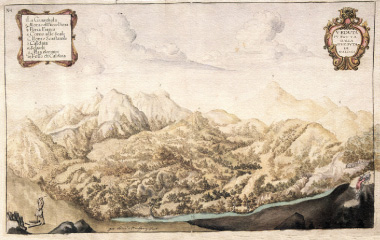 |
|
|
|


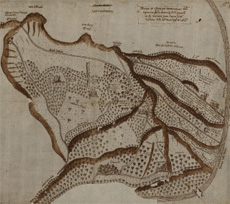 The Florentine
government always put great care and attention in the maintaining the
good condition of the forests and woods of Pistoia's Mountains, specifically
when the production of wood and coal became fundamental for the iron industry
in the 16th century. All the mountain areas of the Grand Duchy were then
placed under strict binding legislation, guaranteed by a series of inspections
carried out by the Grand Duke's executives.
The Florentine
government always put great care and attention in the maintaining the
good condition of the forests and woods of Pistoia's Mountains, specifically
when the production of wood and coal became fundamental for the iron industry
in the 16th century. All the mountain areas of the Grand Duchy were then
placed under strict binding legislation, guaranteed by a series of inspections
carried out by the Grand Duke's executives.